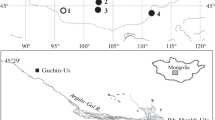Abstract
Seven fossil sites of Mesozoic mammals have been discovered in Russia: four in Western Siberia (one Middle Jurassic and three Early Cretaceous), one in European Russia (Middle Jurassic), one in Transbaikalia (Early Cretaceous), and one in the Far East (Late Cretaceous). The specimens represent most of the ancient mammal groups known to have lived in the northern hemisphere. The finds suggest that, with further exploration, Russia may become a major source of data on Mesozoic mammals.
Similar content being viewed by others
References
Z.-X. Luo, “Transformation and Diversification in Early Mammal Evolution,” Nature 450(7172) (2007).
Y. Hu, J. Meng, Y. Wang, and Ch. Li, “Large Mesozoic Mammals Fed on Young Dinosaurs,” Nature 433(7022) (2005).
Z.-X. Luo and J. R. Wible, “A Late Jurassic Digging Mammal and Early Mammalian Diversification,” Science 308(5718) (2005).
Q. Ji, Z.-X. Luo, Ch.-X. Yuan, and A. R. Tabrum, “A Swimming Mammaliaform from the Middle Jurassic and Ecomorphological Diversification of Early Mammals,” Science 311(5764) (2006).
J. Meng, Y. Hu, Y. Wang, et al., “A Mesozoic Gliding Mammal from Northeastern China,” Nature 444(7121) (2006).
J. H. Hurum, Z-X. Luo, and Z. Kielan-Jaworowska, “Were Mammals Originally Venomous?,” Acta Palaeontol. Pol. 51(1) (2006).
Z. Kielan-Jaworowska and J. H. Hurum, “Limb Posture in Early Mammals: Sprawling Or Parasagittal,” Acta Palaeontol. Pol. 51(3) (2006).
Z. Kielan-Jaworowska, R. L. Cifelli, and Z.-X. Luo, Mammals from the Age of Dinosaurs: Origins, Evolution, and Structure (Columbia Univ. Press, New York, 2004).
E. N. Maschenko and A. V. Lopatin, “First Record of an Early Cretaceous Triconodont Mammal in Siberia,” Bull. Inst. Roy. Sci. Nat. Belg. Sci. Terre 68 (1998).
P. P. Gambaryan and A. O. Averianov, “Femur of a Morganucodontid Mammal from the Middle Jurassic of Central Russia,” Acta Palaeontol. Pol. 46(1) (2001).
A. O. Averianov, A. V. Lopatin, P. P. Skutschas, et al., “Discovery of Middle Jurassic Mammals from Siberia,” Acta Palaeontol. Pol. 50(4) (2005).
A. V. Lopatin and A. O. Averianov, “A New Docodont (Docodonta, Mammalia) from the Middle Jurassic of Siberia,” Dokl. Akad. Nauk 405(2) (2005) [Dokl. Biol. Sci. 405, 434–436 (2005)].
A. O. Averianov and A. V. Lopatin, “Itatodon tatarinovi (Tegotheriidae, Mammalia), Docodont from the Middle Jurassic of West Siberia and Phylogenetic Analysis of Docodonta,” Paleontol. Zh., No. 6 (2006).
A. V. Lopatin and A. O. Averianov, “Mesozoic Mammals of Russia,” in 9 International Symposium on Mesozoic Terrestrial Ecosystems and Biota (Manchester, 2006).
A. V. Lopatin and A. O. Averianov, “The Earliest Asiatic Pretribosphenic Mammal (Cladotheria, Amphitheriidae) from the Middle Jurassic of Siberia,” Dokl. Akad. Nauk 417(1) (2007) [Dokl. Biol. Sci. 417, 432–434 (2007)].
A. O. Averianov and P. P. Skuchas, “The Earliest Placentary Mammal,” Dokl. Akad. Nauk 374(1) (2000).
A. O. Averianov and P. P. Skutschas, “A Eutherian Mammal from the Early Cretaceous of Russia and Biostratigraphy of the Asian Early Cretaceous Vertebrate Assemblages,” Lethaia 33(4) (2000).
A. O. Averianov and P. P. Skutschas, “A New Genus of Eutherian Mammal from the Early Cretaceous of Transbaikalia, Russia,” Acta Palaeontol. Pol. 46(3) (2001).
A. O. Averianov, P. P. Skutschas, A. V. Lopatin, et al., “Early Cretaceous Mammals from Bol’shoi Kemchug 3 Locality in West Siberia, Russia,” Russ. J. Theriol. 4(1) (2005).
A. V. Lopatin, E. N. Mashchenko, A. O. Averianov, et al., “Early Cretaceous Mammals from West Siberia. 1. Tinodontidae,” Paleontol. Zh., No. 5 (2005).
A. O. Averianov and A. V. Lopatin, “’Protocone’ in a Pretribosphenic Mammal and Upper Dentition of Tinodontid ‘symmetrodontans’,” J. Vertebr. Paleontol. 28(2) (2008).
A. V. Lopatin and A. O. Averianov, “An Aegialodontid Upper Molar and the Evolution of Mammal Dentition,” Science 313(5790) (2006).
A. V. Lopatin and A. O. Averianov, “Kielantherium, a Basal Tribosphenic Mammal from the Early Cretaceous of Mongolia, with New Data on Aegialodont Dentition,” Acta Palaeontol. Pol. 52(3) (2007).
E. N. Maschenko, A. V. Lopatin, and A. V. Voronkevich, “A New Genus of the Tegotheriid Docodonts (Docodonta, Tegotheriidae) from the Early Cretaceous of West Siberia,” Russ. J. Theriol. 1(2) (2003).
E. N. Mashchenko, A. V. Lopatin, and A. V. Voronkevich, “A New Early Cretaceous Mammal from West Siberia,” Dokl. Akad. Nauk 386(5) (2002).
A. V. Lopatin and A. O. Averianov, “Mesozoic Mammals in Russia: Results and Perspectives of Study,” in Theriofauna of Russia and Adjacent Territories (VIII Congress of the Theriological Society): Materials of the International Conference (KMK, Moscow, 2007).
A. O. Averianov, Yu. L. Bolotsky, and P. Godefroit, “First Multituberculate Mammal from Russia,” in IV Intern. Sympos. IGCP 434. Cretaceous Continental Margin of East Asia: Stratigraphy, Sedimentation, and Tectonic. Program and Abstracts (Khabarovsk, 2002).
Author information
Authors and Affiliations
Additional information
Original Russian Text © A.V. Lopatin, A.O. Averianov, 2009, published in Vestnik Rossiiskoi Akademii Nauk, 2009, Vol. 79, No. 6, pp. 523–529.
Rights and permissions
About this article
Cite this article
Lopatin, A.V., Averianov, A.O. Mammals that coexisted with dinosaurs. Her. Russ. Acad. Sci. 79, 268–273 (2009). https://doi.org/10.1134/S1019331609030113
Published:
Issue Date:
DOI: https://doi.org/10.1134/S1019331609030113




